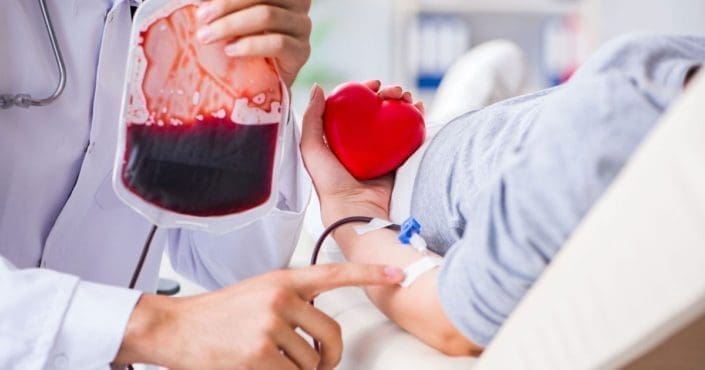
What is anemia?
Anemia is the most common blood disorder in the United States. It affects your red blood cells and hemoglobin. Hemoglobin is the protein in red blood cells that carries oxygen from your lungs to the rest of your body. You need iron in order to make hemoglobin. Most people who have anemia have a shortage of iron. This condition is called iron deficiency anemia.
There are a few other types of anemia, including:
- Aplastic anemia. This occurs when your bone marrow has damaged stem cells. Your body fails to produce enough new blood cells. The condition affects your red blood cells, white blood cells, and platelets. Sometimes it is called bone marrow failure.
- Hemolytic anemia. This occurs when your body destroys red blood cells before they should. The normal lifespan of red blood cells is 120 days.
- Normocytic anemia. This occurs when your red blood cells are normal in size, but low in count.
- Pernicious anemia. This occurs when your body lacks vitamin B12. It causes a shortage of healthy red blood cells.
- Sickle cell anemia (a form of sickle cell disease). This is a genetic disease that affects your red blood cells. It occurs when you are born with 2 abnormal hemoglobin genes.
Symptoms of anemia
Mild forms of anemia may not cause any symptoms. Fatigue, or feeling tired, is a common symptom. This is because the hemoglobin in red blood cells carries oxygen. A lack of oxygen reduces energy. It can cause your heart to work harder to pump oxygen. Other common anemia symptoms include:
- Paleness
- Shortness of breath
- Cold hands and feet
- Headaches
- Dizziness
- Fast, slow, or uneven heartbeat
- Brittle nails or hair loss
- Strange food cravings (known as pica)
Contact your doctor if you have any of these symptoms. They can diagnose the type and cause of the condition.
What causes anemia?
There are three main reasons why anemia occurs.
-
Your body can’t produce enough red blood cells.
Not being able to produce enough red blood cells can happen for several reasons, including diet, pregnancy, disease, and more.
Diet
Your body may not produce enough red blood cells if you lack certain nutrients. Low iron is a common problem. People who don’t eat meat or follow “fad” diets are more at risk of low iron. Infants and toddlers are at risk of getting anemia from a low-iron diet. Not having enough vitamin B12 and folic acid can cause anemia as well.
Absorption difficulty
Certain diseases affect your small intestine‘s ability to absorb nutrients. For example, Crohn’s disease and celiac disease can cause low iron levels in your body. Some foods, like milk, can prevent your body from absorbing iron. Taking vitamin C can help this. Medicines, such as antacids or prescriptions to reduce acid in your stomach, can affect it as well.
Pregnancy
People who are pregnant or breastfeeding can get anemia. When you’re pregnant, you need more blood (up to 30% more) to share with the baby. If your body lacks iron or vitamin B12, it can’t produce enough red blood cells.
The following factors may increase your risk of anemia during pregnancy:
- Vomiting a lot from morning sickness
- Having a diet low in nutrients
- Having heavy periods before pregnancy
- Having 2 pregnancies close together
- Being pregnant with multiple babies at once
- Becoming pregnant as a teenager
- Losing a lot of blood from an injury or surgery
Growth spurts
Children younger than 3 years of age are prone to anemia. Their bodies grow so fast that they can have a hard time getting or keeping enough iron.
Normocytic anemia
Normocytic anemia can be congenital (from birth) or acquired (from a disease or infection). The most common cause of the acquired form is a chronic (long-term) disease. Examples include kidney disease, cancer, rheumatoid arthritis, and thyroiditis. Some medicines can cause normocytic anemia, but this is rare.
-
Your body destroys red blood cells early and faster that they can be replaced.
Treatments, such as chemotherapy, can damage your red blood cells and/or bone marrow. Infection caused by a weakened immune system can lead to anemia. You may be born with a condition that destroys or remove red blood cells. Examples include sickle cell disease, thalassemia, and a lack of certain enzymes. Having an enlarged or diseased spleen can cause anemia, too.
-
You have blood loss that creates a shortage of red blood cells.
Heavy periods may cause low iron levels in women. Internal bleeding, such as in your digestive or urinary tract, can cause blood loss. This can be caused by conditions such as a stomach ulcer or ulcerative colitis. Other reasons for blood loss include:
- Cancer
- Surgery
- Trauma
- Taking aspirin or a similar medicine for a long time
How is anemia diagnosed?
Talk to your doctor if you think you or your child might have anemia. They will do a physical exam and review your health history and symptoms. To diagnose anemia, your doctor will test your blood. This test is called a complete blood count (CBC). Based on the results, they may need to do other tests, such as testing your bone marrow. This can help confirm the cause of anemia or another health condition.
Can anemia be prevented or avoided?
You cannot avoid anemia caused by a genetic disease. You often cannot avoid it due to blood loss. If your blood loss is from heavy periods, receiving treatment can help prevent anemia. If your body can’t absorb certain nutrients, such as iron or vitamin B12, talk to your doctor about taking a supplement. This can help manage your levels and prevent anemia.
A balanced diet can help prevent some types of anemia. Eat foods high in iron to prevent a deficiency.
Foods high in iron include:
- Red meat
- Seafood
- Organ meats (such as liver)
- Whole grains
- Dried fruits
- Nuts
- Beans (especially lima beans)
- Dark green leafy vegetables (such as spinach and broccoli)
- Iron-fortified foods like breads and cereals (check the label)
Vitamin C can help your body absorb iron. Try eating foods rich in vitamin C, such as citrus fruits or juice, peppers, and broccoli. Some foods can make it harder for your body to absorb iron. These include coffee, tea, milk, egg whites, fiber, and soy protein. Try to avoid these foods if you have iron deficiency anemia.
Foods high in vitamin B12 include:
- Meat and poultry
- Organ meats (such as liver)
- Fish and shellfish
- Eggs, milk, and dairy products
- Some fortified cereals, grains, and yeasts (check the label)
Foods high in folic acid (folate) include:
- Dark green leafy vegetables (such as spinach and broccoli)
- Asparagus
- Beans
- Peas
- Lentils
- Bananas, oranges, and orange juice
Pregnant people may be tested for anemia or take an iron supplement to help prevent it. However, the American Academy of Family Physicians (AAFP) has insufficient evidence to assess the benefits and risks of screening all pregnant people for iron deficiency anemia or having them take an iron supplement.
Evidence also is lacking to measure the benefits and risks of screening children ages 6 to 24 months. To help prevent your child from getting iron deficiency anemia, you can:
- Use iron-fortified formula
- Use iron-fortified cereal starting around 4 months of age
- Limit your child to less than 24 oz. (3 cups) of cow’s milk per day (after 12 months of age)
- Introduce foods high in iron starting around 12 months of age
Warning: Keep all products with iron stored out of reach of your child. Iron can be toxic if taken in large amounts.
Anemia treatment
There are many treatment options for anemia. They vary based on the type, cause, and severity, as well as your overall health. The first goal of treatment is to create more healthy red blood cells that can carry enough oxygen to your body. Often this is achieved by increasing your red blood cell count and/or hemoglobin. The other goal is to treat the cause, if possible. For example, if anemia results from losing too much blood, your doctor will need to treat the cause of your blood loss.
If you have a type of anemia caused by a deficiency, make changes to your diet. This can increase your nutrient levels or help your body absorb nutrients.
In some cases, your doctor can prescribe medicine to help your body produce more red blood cells. Examples include:
- Erythropoietin shots to treat normocytic anemia (these can help your bone marrow produce more red blood cells)
- Hormone medicines to treat heavy periods
- Antibiotic medicines to treat infections
- Medicines to help prevent your body from damaging or destroying red blood cells
Other forms of anemia require intense treatment. You may need surgery to stop blood loss or have your spleen removed. Other treatments include a blood transfusion or a blood and bone marrow stem cell transplant.
Talk to your doctor about how to manage a chronic disease or other health problem that causes anemia.
Living with anemia
Following treatment, most people go on to live normal, healthy lives. However, anemia can have lasting, or life-threatening, effects. These are more common if the condition is chronic, severe, or left untreated. They include:
- Arrhythmia. This is an issue with your heartbeat. It can be too fast, too slow, or uneven. Over time, this can lead to heart disease or heart failure.
- Organ damage. This can occur if an organ doesn’t get enough oxygen.
- Weakened immune system. This can be fatal if your immune system already is weak from cancer, disease (such as HIV/AIDS), or an infection.
Children who have iron deficiency anemia have a higher risk of lead poisoning. They also can develop mental, motor, or behavioral problems over a long time.
Pregnant women who have iron deficiency anemia may have their baby premature or at a low birth weight. There also is a risk of needing a blood transfusion if you lose a lot of blood during delivery. Anemia may be associated with postpartum depression.
Questions to ask your doctor
- If I have anemia once, will I always have it, or will it come back again?
- If I have anemia during pregnancy, is there a risk of passing it to my children?
- If I have anemia during pregnancy, am I more at risk of having it after?
- If I have a health condition that causes anemia, what is the risk of passing it to my children?
![]()
Copyright © American Academy of Family Physicians
This information provides a general overview and may not apply to everyone. Talk to your family doctor to find out if this information applies to you and to get more information on this subject.








